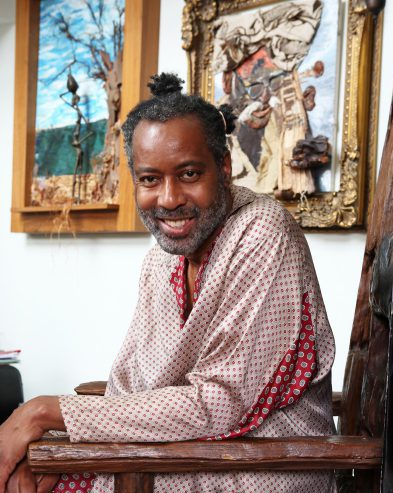Creating art uplifts the body and soul
By Constance Garcia-Barrio
Treasure each day, we’re often told. Multimedia artist Terrence L. Gore, 56, of West Philadelphia, needs no reminding. “Doctors gave me 30 days to live at one point,” he says. “They made that prediction 15 years ago.”
In his 20s and 30s, Gore rocketed through life as a chef, hair stylist, interior designer, dancer, and world traveler. “As an artist, I am curious about other cultures,” Gore says. “I’ve gone all over the globe, staying mostly in villages, and I’ve rollerbladed through New York, Paris, Madrid and London.”
In 2005, Gore’s carefree life screeched to a halt. “In dance class, I noticed numbness in my right toe and couldn’t stabilize my balance,” he says. “I visited Dr. Shen, a Chinese acupuncturist and naturopathic doctor (who) I’d been seeing for years. He examined me and asked if I’d been tested for HIV. When I said, ‘Why would you ask?’ he said that the infection was in my brain.”
By February 2006, a neurologist confirmed a rare brain lesion, called progressive multifocal leukoencephalopathy (PML), caused by HIV. “By then, my whole right side was weak, and I couldn’t work,” Gore says. Days later, he went into a coma that lasted for nine days. “When I regained consciousness, I couldn’t speak or move my right side, and I’d gone blind in my right eye. It looked like I’d had a stroke.”
At first, anger consumed him. Gore spent a year in the hospital, but slowly regained speech and some vision in his right eye. Later, he did strengthening exercises and began using a walker, then a cane.
Right-handed but unable to use that hand, he would ask friends who visited to bring magazines and cut out images. Then he would use his left hand to place the cutouts to create a collage. He also dried flowers that were given to him and incorporated them in the collage.
He also handled the challenge of what to tell loved ones. “Some friends advised me to say that I’d had a stroke, not that I was fighting HIV/AIDS,” Gore says. “I decided to tell the truth so that I could educate young people about the effects of the illness.”
Battling PML eventually led Gore to South Philadelphia’s Fleisher Art Memorial for classes in painting and drawing, which he enjoyed in childhood. “Every time I thought about what I had lost physically, I would start an art project,” he says. “It always lifts my spirits.”
The story of self-taught Black folk painter Horace Pippin inspired Gore. Shot in the shoulder by a German sniper in World War I, Pippin lost range of motion in his right arm and taught himself to paint with his left hand. Gore, weakened on his right side, likewise learned to paint with his left hand. He’s had two, one-man shows of his multimedia art. In 2017, a collage he created won first prize in Woodmere Art Museum’s 76th annual juried exhibition.
Now, Gore feels both stronger and more creative. He walks with a brace that lifts his right foot, but has already lived 100 times longer than the usual six-month estimate from diagnosis to demise. That achievement inspired him to start a workshop series, called “The Art of Healing,” in 2012 at The Painted Bride. “The workshops are designed to promote physical, emotional and spiritual well-being,” Gore says.
This spring, Gore will present art workshops for adults 65 and older at Bartram’s Garden. “The pandemic has hit seniors especially hard,” he says. “I think of my mother, in her 70s, who’s living with the restrictions of COVID-19. (The workshops are) a chance for participants to celebrate themselves and feel renewed.”
***
For more information, about Gore’s work, go to terrencelgore.com.
Native Philadelphian Constance Garcia-Barrio writes about many topics, including Black history




